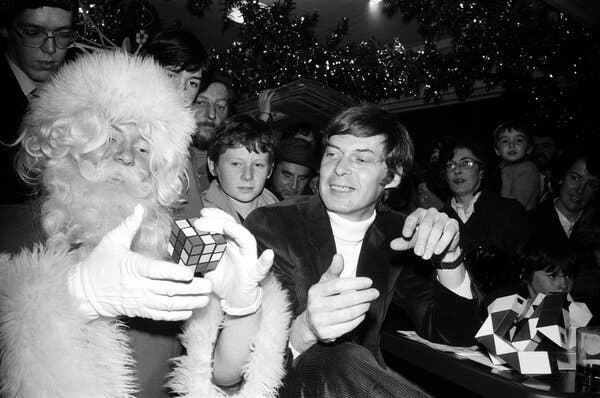Bright and early on the first Saturday in January, Tomas Rokicki and a few hundred fellow enthusiasts gathered in a vast lecture hall at the Moscone Center in downtown San Francisco. A big math conference was underway and Dr. Rokicki, a retired programmer based in Palo Alto, Calif., had helped organize a two-day special session about “serious recreational mathematics” celebrating the 50th anniversary of the Rubik’s Cube. Erno Rubik, the Cube’s inventor, was top of the show at 8 a.m., via videoconference from the south of Spain.
Mr. Rubik, a Hungarian architect, designer, sculptor and retired professor, took part in a question-and-answer session with Dr. Rokicki and his co-organizers, Erik Demaine, a computer scientist at M.I.T., and Robert Hearn, a retired computer scientist, of Portola Valley, Calif.
Dr. Rokicki asked Mr. Rubik about the first time he solved the Cube: “Did you solve corners-first?”
These days, new cubers learn on YouTube, watching tutorials at 1.5x speed. Dr. Rokicki instead recommends the old-fashioned strategy: Set out on a lone path and discover a solving method, even if it takes weeks or months. (It took the computer scientist Donald Knuth less than 12 hours, starting at his dining table in the evening and working straight through to the morning.) Corners-first is a common route, since once the corners are solved, the edges can be slotted in with relative ease. Mr. Rubik said that, yes, he indeed did corners-first. Mr. Rubik, who is known to take a philosophical approach to cubology and to life in general, added: “My method was understanding.”
‘Cubitus magikia’
Mr. Rubik dates the Cube to the spring of 1974. Preparing a course on descriptive geometry and tinkering with the five Platonic solids, he had become especially taken by the cube. But, as he wrote in his 2020 memoir, “Cubed, The Puzzle of Us All,” for quite a while it “never once occurred to me that I was creating a puzzle.”
By about the time of his 30th birthday, in July 1974, he had created the structure, realized its puzzling potential and — after playing with it intermittently for a few months — solved the Cube for the first time. He submitted a patent application in January 1975, and by the end of 1977 the “Magic Cube” had debuted in toy stores in Hungary. Travelers spirited it out “in their luggage, next to other Hungarian delicacies like sausage and Tokaji wine,” he recalled.
